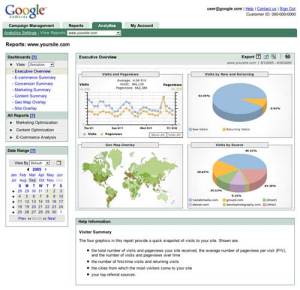[Editor’s note: This is the third in a series of practical advice for entrepreneurs — things you’re probably aware of but are likely to forget in the rush of launching a business.]
You’d be surprised how many startups don’t see the value in their Web traffic data.
All too often when I meet with a startup, the only statistics the owner has on hand is a basic set of website logs from their web hosting company – logs which they rarely have analyzed or looked at in depth. Further, they often have few processes (if any) set up to track activity across the web.
That’s a critical mistake. Analytics are a window into the demographics and habits of both your customers and potential customers. Setting up analytics processes should be one of the first things you do as you launch your business.
AI Weekly
The must-read newsletter for AI and Big Data industry written by Khari Johnson, Kyle Wiggers, and Seth Colaner.
Included with VentureBeat Insider and VentureBeat VIP memberships.
Fortunately, this isn’t as hard as it might seem. There are several good website analytics packages available, including Google Analytics (formerly Urchin) and the Quantcast.
Google Analytics offers a great deal of customization and detailed website traffic data, but even the most basic data can give you useful information to help grow your startup.
Quantcast offers a third-party view of your website traffic. The advantage here is you can share the data with others in a controlled, yet validated, manner.
Google has recently opened up the ability to publish and share your site’s Google Analytics data both within their Ad Planner tools for ad buyers and on a public basis. Even with this new feature, I still recommend Quantcast as offering an additional way to collect and share data about your website traffic.
Initially there are two main analytics goals you should set. First, you’ll want to establish a baseline of the traffic to your site. You’ll also want to be able to detect new traffic and observe how people use your site and applications.
Once you have a baseline established, you have a sense of how much traffic shows up at your site just on the strength of the domain name. For many startups this may be zero. The point, though, is to identify the level of traffic initially and to observe how the baseline changes over time.
With good analytics you will be able see what articles are sending traffic to your site, what search terms visitors are using, where that traffic is coming from, and many other details about the visitors to your site.
You may quickly find that the majority of your traffic doesn’t come from mainstream media, high profile tech blogs or even social news sites like Digg.com. Oftentimes, focused niche blogs can steer more people your way. Without good analytics and a baseline, however, entrepreneurs may extrapolate data using their own reading habits as a baseline and end up focusing on the wrong media for their outreach efforts.
Your second goal – learning how people use your site or service – could be the most valuable information you collect. Once you have traffic and users, start building up statistics on which links they follow (and which they don’t). What features of your application are they using? Where in the process of registering do they give up?
Try to avoid going metrics happy – tracking too many variables or focusing on correlations that are not meaningful. The key is to gather a lot of data and to use the best available tools to pull out patterns from that data.
Before you launch, you should define a range of goals for traffic on a your site. For some companies this might be “apply for a job with us”. For others, it might be “buy our products” or “sign up for our beta”. Even if you’re at a very early stage or still in stealth mode, your site can work for you. This is also a good time to plug your company’s blog or twitter account to keep interested parties up to date on your progress and begin building buzz about your business.
It’s also a good time to begin experimenting with alternative marketing methods, such as Adwords. Eric Ries, who writes the Startup Lessons Learned blog, offers some very good advice on this topic.
With a baseline established and with good analytics about how visitors are interacting with your site, you’ll be in a position to start A/B testing (or variant testing, if you prefer).
While it’s often associated with ways of monetizing traffic, A/B testing doesn’t have to be that narrowly focused.
In essence, this is the art of making a single, small changes to your website. A limited portion of your site visitors (typically 50 percent or so) then sees the changes. By comparing traffic patterns of users who see the changes to those of people seeing the existing site, you’ll be able to learn if your tweaks will make a measurable difference.
Whether the results are positive or negative is irrelevant. Either way, you’re better able to learn about your customers, their habits and what changes impact their behavior.
As you build your startup, a thorough understanding and study of your site’s analytics will enable you to answer critical questions from investors about how you plan to grow your business – not in abstract terms, but in data-backed specifics.
Want more Starting up 101 stories?
Choosing your core collaboration tools
VentureBeat's mission is to be a digital town square for technical decision-makers to gain knowledge about transformative enterprise technology and transact. Learn More